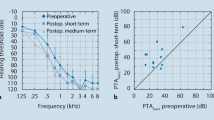Abstract
Purpose
To evaluate the long-term hearing outcomes in cochlear implanted adults with residual hearing at low frequencies, and the proportion of patients using electro-acoustic stimulation (EAS).
Methods
A monocentric retrospective cohort study was performed in a tertiary referral center. Population demographics, surgical approach, pre- and postoperative hearing at low frequencies, in the implanted and contralateral ear, were recorded as well as duration of EAS use. The percentage hearing preservation was calculated according to the formula S (HEARRING group).
Results
In total, 63 adults (81 ears) with residual hearing underwent cochlear implantation with intent to use EAS processors. Six different types of electrode array were implanted. The mean pure tone audiometry (PTA) shift after cochlear implantation was 16 ± 15 dB HL (range 0–59 dB HL). Half of the implanted ears had minimal hearing preservation or total hearing loss (HL) at 5.5 years and the cumulative risk of total HL was 50% at 7 years. During the follow-up, total HL occurred in 22 ears. The decrease in hearing levels was similar in both implanted and contralateral ear during follow-up (ns, F = 2.46 ± 3, Linear Mixed Model (LMM)). Only 44 patients found a benefit from EAS at the first fitting. At the last visit, EAS processors were fitted in 30% of the cases. The pre- and postoperative mean PTA thresholds were not predictive of EAS use (Cox’s proportional hazards analysis).
Conclusions
Postoperative residual hearing was observed in 93% of implanted ears, but only half of them had an initial benefit from EAS. No predictive factors were found to influence the use of EAS processors.


Similar content being viewed by others
References
Von Ilberg C, Kiefer J, Tillein J et al (1999) Electric-acoustic stimulation of the auditory system. ORL 61:334–340
Lehnhardt E (1993) Intracochlear placement of cochlear implant electrodes in soft surgery technique. HNO 41:356–359
Gantz BJ, Dunn C, Oleson J et al (2017) Multicenter clinical trial of the Nucleus Hybrid S8 cochelar implant : final outcomes. Laryngoscope 126:962–973. https://doi.org/10.1002/lary.25572.Multicenter
Nguyen Y, Mosnier I, Borel S et al (2013) Evolution of electrode array diameter for hearing preservation in cochlear implantation. Acta Otolaryngol 133:116–122. https://doi.org/10.3109/00016489.2012.723824
Santa Maria PL, Gluth MB, Yuan Y et al (2014) Hearing preservation surgery for cochlear implantation : a meta-analysis. Otol Neurotol 35:256–269. https://doi.org/10.1097/MAO.0000000000000561
Hunter JB, Gifford RH, Wanna GB et al (2016) Hearing preservation outcomes with a Mid-Scala electrode in cochlear implantation. Otol Neurotol 37:235–240. https://doi.org/10.1097/MAO.0000000000000963
Helbig S, Adel Y, Rader T, Sto T (2016) Long-term hearing preservation outcomes after cochlear implantation for electric-acoustic stimulation. Otol Neurotol 37:353–359. https://doi.org/10.1097/MAO.0000000000001066
Erixon E, Köbler S, Rask-Andersen H (2012) Cochlear implantation and hearing preservation : results in 21 consecutively operated patients using the round window approach. Acta Otolaryngol 132:923–931. https://doi.org/10.3109/00016489.2012.680198
Adunka OF, Dillon MT, Adunka MC et al (2013) Hearing preservation and speech perception outcomes with electric-acoustic stimulation after 12 months of listening experience. Laryngoscope 123:2509–2515. https://doi.org/10.1002/lary.23741
Lenarz T, James C, Cuda D et al (2013) European multi-centre study of the Nucleus Hybrid L24 cochlear implant. Int J Audiol 52:838–848. https://doi.org/10.3109/14992027.2013.802032
Moran M, Dowell RC, Iseli C, Briggs RJS (2017) Hearing preservation outcomes for 139 cochlear imlant recipients using a thin straight electrode array. Otol Neurotol 38:678–684. https://doi.org/10.1097/MAO.0000000000001374
Usami S, Moteki H, Tsukada K et al (2014) Hearing preservation and clinical outcome of 32 consecutive electric acoustic stimulation surgeries. Acta Otolaryngol 134:717–727. https://doi.org/10.3109/00016489.2014.894254
Lenarz T, Buechner A, Lesinski-Schiedat A et al (2009) Hearing conservation surgery using the Hybrid-L electrode. Audiol Neurotol 14:22–31. https://doi.org/10.1159/000206492
Briggs RJS, Tykocinski M, Lazsig R et al (2011) Development and evaluation of the modiolar research array—multi-centre collaborative study in human temporal bones. Cochlear Implant Int 12:129–139
Moteki H, Nishio S, Miyagawa M et al (2017) Long-term results of hearing preservation cochlear implant surgery in patients with residual low frequency hearing. Acta Otolaryngol 137:516–521
Mertens G, Punte AK, Cochet E et al (2014) Long-term follow-up of hearing preservation in electric-acoustic stimulation patients. Otol Neurotol 35:1765–1772
Skarzynski H, Van de Heyning P, Agrawal S, Arauz SL (2013) Towards a consensus on a hearing preservation classi fi cation system. Acta Otolaryngol 133:3–13. https://doi.org/10.3109/00016489.2013.869059
Gstoettner W, Helbig S, Settevendemie C et al (2009) A new electrode for residual hearing preservation in cochlear implantation : first clinical results. Acta Otolaryngol 129:371–379. https://doi.org/10.1080/00016480802552568
James CJ, Fraysse B, Deguine O et al (2006) Combined electroacoustic stimulation in conventional candidates for cochlear implantation. Audiol Neurotol 11:57–62. https://doi.org/10.1159/000095615
Causon A, Verschuur C, Newman TA (2015) A retrospective analysis of the contribution of reported factors in cochlear implantation on hearing preservation outcomes. Audiol Neurootol 36:1137–1145
Erixon E, Rask-Andersen H (2015) Hearing and patient satisfaction among 19 patients who received implants intended for hybrid hearing. Ear Hear 36:271–278
Santa Maria PL, Domville-lewis C, Sucher CM et al (2013) Hearing preservation surgery for cochlear implantation: hearing and quality of life after 2 years. Otol Neurotol 34:526–531
Gantz BJ, Dunn C, Oleson J et al (2017) Multicenter clinical trial of the Nucleus Hybrid S8 Cochlear implant: final outcomes. Laryngoscope 126:962–973. https://doi.org/10.1002/lary.25572.Multicenter
James C, Albegger K, Battmer R et al (2005) Preservation of residual hearing with cochlear implant: how and why. Acta Otolaryngol 125:481–491
Sun C, Hsu C, Chen P, Wu H (2015) Residual hearing preservation after cochlear implantation via round window or cochleostomy approach. Laryngoscope 125:1715–1719. https://doi.org/10.1002/lary.25122
Snels C, IntHout J, Mylanus EAM et al (2019) Hearing preservation in cochlear implant surgery: a meta-analysis. Otol Neurotol Neurotol 40:145–153
Acknowledgements
This study has no financial support.
Author information
Authors and Affiliations
Corresponding author
Ethics declarations
Conflict of interest
The authors report no conflicts of interest.
Additional information
Publisher's Note
Springer Nature remains neutral with regard to jurisdictional claims in published maps and institutional affiliations.
Rights and permissions
About this article
Cite this article
Mamelle, E., Granger, B., Sterkers, O. et al. Long-term residual hearing in cochlear implanted adult patients who were candidates for electro-acoustic stimulation. Eur Arch Otorhinolaryngol 277, 705–713 (2020). https://doi.org/10.1007/s00405-019-05745-6
Received:
Accepted:
Published:
Issue Date:
DOI: https://doi.org/10.1007/s00405-019-05745-6




